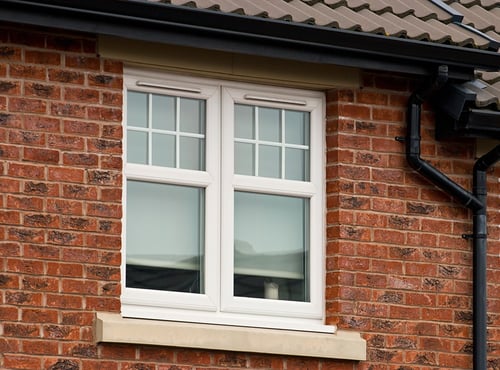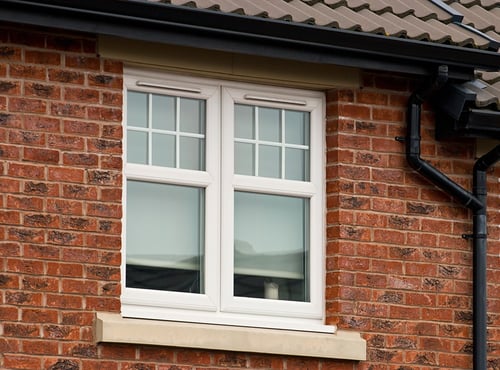Windows are often seen as decorative elements of a building, with the passive role of providing visibility and natural lighting. However, the choice of windows is a very important design decision before construction. Much of the heat exchange between the building and the outside takes place through windows, which influences the energy consumption of heating and cooling equipment.
Defining an appropriate number of windows and their layout is a design challenge:
- A large number of windows provide abundant natural light, which reduces lighting costs.
- However, abundant windows also increase heat gain in the summer and heat loss in the winter, increasing HVAC expenses.
- Additionally, if windows are placed facing the sun, they can cause glare.
Improve the insulation and tightness of your building’s envelope.
Windows thermal performance
A window's resistance to heat flow is determined by its physical construction: double-pane glass transfers less heat than single-pane glass, and in turn, a double-pane window is outperformed by a triple-pane window. . As you would expect, the cost of the window increases along with the number of panes of glass, which means there is a cost-benefit analysis involved.
Three main metrics are used to describe the thermal performance of windows: the U-value, the R-Value , and the solar heat gain coefficient (SGHC).
The U value is the heat transfer coefficient, and describes the heat transferred per unit area and per unit temperature difference. If a window has a U-value of 0.25 W/m2-°C, a 2 m2 window area will transfer 5 watts when exposed to a temperature difference of 10°C.
- Heat transfer = (0.25 W/m2-°C)(2 m2)(10 °C) = 5 W
The R-value describes thermal resistance, and can be obtained by dividing the number 1 by the U-value. For example, a U-value of 0.25 W/m2-°C is equivalent to an R-value of 4 m2-°C/W .
- R-value = 1 / U-value = 1 / (0.25 W/m2-°C) = 4 m2-°C / W
Heat transfer can also be calculated from the R value by applying the following formula:
- Heat Transfer = Area x Temperature Difference / R-Value
- Heat transfer = (2 m2)(10°C) / (4 m2-°C/W) = 5 W
The solar heat gain coefficient (SHGC) is the fraction of solar radiation transmitted through the window. For example, if a window has a SHGC of 0.7 and receives 200W of solar radiation, the heat transmission is 140W (200W x 0.7).
Improve natural lighting and prevent glare
Natural lighting with windows reduces dependence on luminaires, reducing the operational cost of artificial lighting. However, poorly positioned windows can cause glare if the sun is directly visible or reflected by an interior surface. Distraction caused by glare reduces productivity and prolonged exposure is harmful to human vision. Note that there are two types of glow :
- Discomfort glare happens when a bright light source causes pain and an instinctive reaction to look away. For example, this is the type of glare if you accidentally look at the sun.
- Glare impairment occurs when vision is impaired but without the instinctive reaction to look away. A common example is when a light source is reflected from a TV or computer screen – there is no visual pain, but the images on the screen cannot be seen clearly.
Glare can be avoided by avoiding windows facing directly into the sun or strategically blocking it with vegetation and blinds. Skylights are also viable when there is no floor above – their geometry is optimized to allow natural lighting without glare and heating effects.
Artificial lighting can be enhanced with controls to make it responsive to natural lighting, through a concept called daytime harvesting . Luminaires are dimmed or turned off in response to natural lighting and, as a result, their electricity consumption is reduced.
Effect on Windows on Heating and Cooling Expenses

A building can be equipped with the most efficient heating and cooling systems available, but performance will continue to be poor if the building envelope does not have adequate insulation and airtightness. A large fraction of summer heat gain and winter heat loss occurs at windows, and the effect on energy bills can be significant if the thermal performance of windows is poor.
High-performance windows are easier and less expensive to install in a new building, as there is no need to modify existing walls. A window upgrade project is more expensive in an existing building as current windows must be removed and there is also masonry work. Storm windows are an economical option in existing buildings: they can be installed without disturbing existing windows, and the resulting air space between the old window and the storm window improves insulation.
Conclusion
Energy efficiency measures tend to focus on specific building systems, but a better approach is to work with the building's overall performance. With smart window selection and proper layout, windows can reduce lighting expenses while minimizing glare and HVAC costs. On the other hand, careless use of windows can hinder energy efficiency upgrades, reducing your return on investment.

